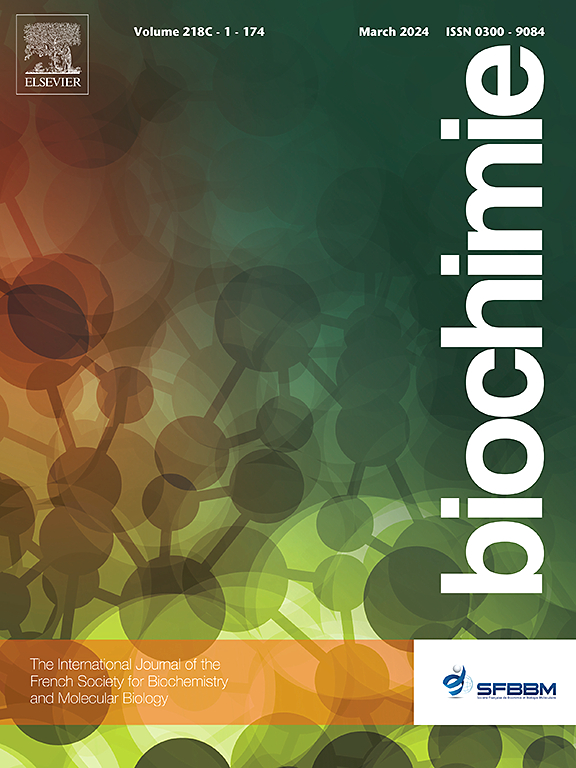Cloning, Expression, Characterization and in silico studies of l-asparaginase from Vibrio sp. (GBPx3)
IF 3
3区 生物学
Q2 BIOCHEMISTRY & MOLECULAR BIOLOGY
引用次数: 0
Abstract
l-asparaginase is a critical therapeutic enzyme for treating acute lymphoblastic leukemia (ALL), a common childhood malignancy. In this study, the l-asparaginase coding sequence from halophilic Vibrio sp. (GBPx3) was cloned, expressed in Escherichia coli, and characterized. The enzyme exhibited a molecular weight of 39.2 kDa and demonstrated a Km of 4.517 mM, kcat of 2.88 1/s, and Vmax of 0.1055 μmol/min, reflecting high specificity for l-asparagine and minimal activity (0.4 %) toward l-glutamine. Optimal activity was observed at physiological conditions (37 °C, pH 7.5 and 125–150 mM NaCl), consistent with human serum osmolality. The half-life of the enzyme was 2.64 h in human serum at 37 °C that is longer than the half-life reported for E. coli l-asparaginase. Additionally, the enzyme had no toxic impact on human umbilical vein endothelial cells (HUVEC) and human erythrocytes. The recombinant l-asparaginase was predicted to be 29.3 % helix, 35.6 % turns, and 35.1 % random by circular dichroism spectroscopy. AlphaFold predicted a 3D structure with promising validation scores. The molecular docking study showed that Thr14, Ser60, Thr91, and Asp92 are putative active site residues, with a negative binding energy of −4.5 kJ/mol for the substrate-enzyme interaction. The enzyme's low immunogenicity, high serum stability, and reduced glutaminase activity highlight its potential as a safer therapeutic alternative. Future experiments and protein engineering studies are needed to explore enzyme's in vivo efficacy and improve its clinical effectiveness.
弧菌(Vibrio sp., GBPx3) l -天冬酰胺酶的克隆、表达、特性及计算机研究
l -天冬酰胺酶是治疗急性淋巴细胞白血病(ALL)的关键治疗酶,是一种常见的儿童恶性肿瘤。本研究克隆了嗜盐Vibrio sp. (GBPx3)的l -天冬酰胺酶编码序列,并在大肠杆菌中进行了表达和鉴定。该酶分子量为39.2 kDa, Km为4.517 mM, kcat为2.88 1/s, Vmax为0.1055 μmol/min,对l -天冬酰胺具有较高的特异性,对l -谷氨酰胺具有最低的活性(0.4%)。在生理条件下(37°C, pH 7.5和125-150 mM NaCl)观察到最佳活性,与人血清渗透压一致。该酶在人血清中37℃的半衰期为2.64小时,比大肠杆菌l -天冬酰胺酶的半衰期长。此外,该酶对人脐静脉内皮细胞(HUVEC)和人红细胞无毒性作用。利用圆二色光谱法预测重组l -天冬酰胺酶的螺旋结构为29.3%,旋转结构为35.6%,随机结构为35.1%。AlphaFold预测了一个具有良好验证分数的3D结构。分子对接研究表明,Thr14、Ser60、Thr91和Asp92是推定的活性位点残基,底物-酶相互作用的负结合能为-4.5 kJ/mol。该酶的低免疫原性、高血清稳定性和降低谷氨酰胺酶活性突出了其作为一种更安全的治疗选择的潜力。进一步的实验和蛋白质工程研究需要进一步探索酶的体内功效,提高其临床疗效。
本文章由计算机程序翻译,如有差异,请以英文原文为准。
求助全文
约1分钟内获得全文
求助全文
来源期刊

Biochimie
生物-生化与分子生物学
CiteScore
7.20
自引率
2.60%
发文量
219
审稿时长
40 days
期刊介绍:
Biochimie publishes original research articles, short communications, review articles, graphical reviews, mini-reviews, and hypotheses in the broad areas of biology, including biochemistry, enzymology, molecular and cell biology, metabolic regulation, genetics, immunology, microbiology, structural biology, genomics, proteomics, and molecular mechanisms of disease. Biochimie publishes exclusively in English.
Articles are subject to peer review, and must satisfy the requirements of originality, high scientific integrity and general interest to a broad range of readers. Submissions that are judged to be of sound scientific and technical quality but do not fully satisfy the requirements for publication in Biochimie may benefit from a transfer service to a more suitable journal within the same subject area.
 求助内容:
求助内容: 应助结果提醒方式:
应助结果提醒方式:


